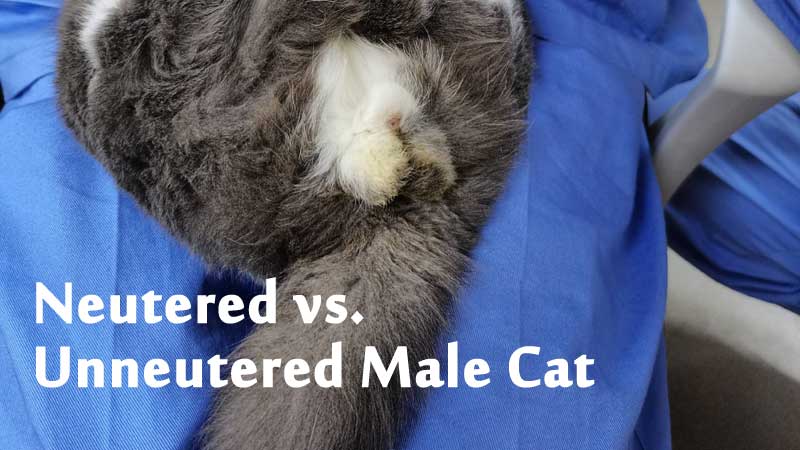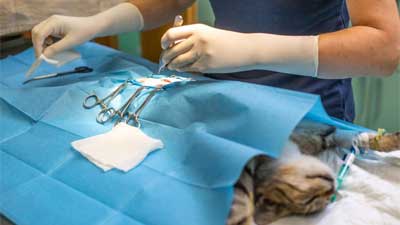Neutered vs. Unneutered Male Cat: Physical and Behavioral

Whether to adopt a male or female cat is one of the first considerations you have to make when bringing home a new pet.
Then, if you choose a male, you must discern whether or not to neuter him. Unless they are designated for use as breeding stock, the majority of male cats kept as companions are neutered (castrated). This widespread practice is to minimize extreme sexual behavior, lessen aggression, and avoid unintentional or random breeding.
You might want to neuter your cat for several medical and behavioral concerns.
What Is Cat Neutering?
Orchidectomy refers to the procedure of neutering or castrating male cats. During the process, an incision is performed over each side of the scrotal sac, which is done under general anesthesia to remove or excise each testicle entirely.
Cats are not given vasectomies since they are sterilized, yet the generation of male hormones is not suppressed. The behavioral advantages of castration come from sterilization and reducing male hormones.
Neutered Male Cats
Physical Characteristics
The age at which a male cat is neutered determines how physically different he is from an unneutered male.
Cats neutered before attaining sexual maturity won't experience any physical changes brought on by hormones, except for the apparent disappearance of testicles. Males who are neutered before six months have small heads, short bodies, and no odor-producing tail glands or penile barbs. They typically have less muscle mass.
Few of the morphological characteristics of an unneutered male cat will remain in males who are neutered after 12 months or when they achieve sexual maturity. Unneutered males have prominent scent glands near their tails and pungent urine.
Neutered cats also tend to be more hygienic.
Behavioral Characteristics
Male cats that have been neutered remain nearby. While some male cats will spray and proclaim their territory, this behavior is far less frequent in males who have undergone neutering.
If they exhibit this behavior, most of them will stop after testosterone is separated from their bodies. They aren't as unfriendly to other male cats, but disputes might still break out, especially if you neuter your male cat when he's an adult. They are less prone to illnesses and infectious diseases since they spend less time fighting.
Additionally, they get along with female cats because they have no sexual attraction to them. They constantly groom themselves and keep their coats clean since they don't feel the need to spend their time seeking a mate.
Unneutered Male Cats
Physical Characteristics
The presence of testicles is the most apparent physical indicator that a male cat has not been neutered. The physical distinctions between neutered and non-neutered cats are determined by testosterone.
Tomcats typically have larger, more muscular bodies, thicker heads, and long necks. The gigantic glands close to their tails also give off a distinct smell.
Tomcat pee emits a powerful, offensive stench because of these smell glands.
Behavioral Characteristics
Tomcats have a strong sense of being territorial. They spray urine to designate their territory, creating a trail of foul-smelling urine in their wake. In search of a mate, tomcats also have strong impulses to travel.
An outdoor tomcat's "home range" is enormous since they frequently travel great distances in search of females. They may become loud if they are locked inside and unable to roam.
Tomcats toward one another see intense hostility.It's crucial to understand that catfights are ferocious and that injuries are likely if you've never been in one.
Tomcats are less groomed than other cats because attracting a female is their primary objective. Unlike their neutered counterparts, they tend to be unclean and pay less attention to grooming.
You May Also Like
 Cat HealthIs Neutering Painful For Cats
Cat HealthIs Neutering Painful For Cats Help & AdviceHow Do I Care For My Cat After Neutering
Help & AdviceHow Do I Care For My Cat After Neutering Help & AdviceHow Do I Know if My Cat Needs to be Neutered?
Help & AdviceHow Do I Know if My Cat Needs to be Neutered? Cat HealthWhat Is The Best Age To Spay Or Neuter A Cat?
Cat HealthWhat Is The Best Age To Spay Or Neuter A Cat? Help & AdviceTo Keep Your Cat Live Longer, These 8 Factors Must Be Paid Attention To
Help & AdviceTo Keep Your Cat Live Longer, These 8 Factors Must Be Paid Attention To Breed ReviewsThe 6 Disadvantages of Male Cats, Can You Accept Them?
Breed ReviewsThe 6 Disadvantages of Male Cats, Can You Accept Them?